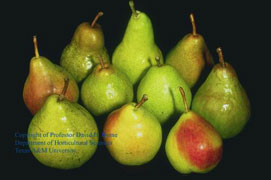


Home
Flowers &
Indoor Plants
Fruits & Nuts
Ornamentals
Vegetables
Special Topics
Resources
Glossary

|
Pear Pyrus communis (pie-rus com-mune-us)     Click on thumbnails for larger image. |
 |
What about it? Pears became popular in America in the early nineteenth century. Once again, John Chapman, the famous Johnny Appleseed, is partly responsible. Pears are a type of fruit known as "pome fruit," as are apples. Pomes have 10 seed compartments filled with one seed each. What is it used for? Pears are eaten fresh and are also enjoyed in preserves. Where does it grow? How do we grow it? Pears prefer gentle slopes. Don't choose frost pockets or poorly drained sites; pears will do best in well-drained soil. Like the other tree fruits, pears will require pruning and training for optimum performance. Pears should be planted in rows spaced 20 feet apart There should also be a 20 foot spacing between each tree in those rows. What are its primary problems? The main insects and diseases found on pears include Fabraea fruit and leaf spot, pear psylla, fireblight, codling moth, and the Glomerella canker that also causes bitter rot. How do we harvest and store it? Harvest when nearly ripe, but not yet soft. Pears will ripen after harvest. Most late cultivars keep well in cold storage.
© Copyright, Department of Horticulture, Cornell University. |